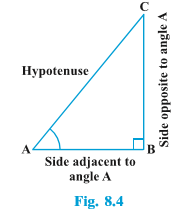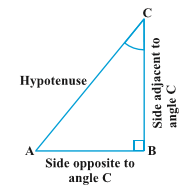- 3.2 Pair of Linear Equations in Two Variables
- Exercise 3.1
- 3.3 Graphical Method of Solution of a Pair of Linear Equations
- Exercise 3.2
- 3.4 Algebraic Methods of Solving a Pair of Linear Equations
- Exercise 3.3
- 3.4.2 Elimination Method
- Exercise 3.4
- 3.4.3 Cross - Multiplication Method
- Exercise 3.5
- 3.5 Equations Reducible to a Pair of Linear Equations in Two Variables
- Exercise 3.6
- Exercise 3.7
8.2 Trigonometric Ratios
8.2 Trigonometric Ratios
Let us take a right triangle ABC as shown in Fig. 8.4.
Here, ∠ CAB (or, in brief, angle A) is an acute angle. Note the position of the side BC with respect to angle A. It faces ∠ A. We call it the side opposite to angle A.
AC is the hypotenuse of the right triangle and the side AB is a part of ∠ A. So, we call it the side adjacent to angle A. the position of sides change when you consider angle C in place of A (see Fig. 8.5).
the position of sides change when you consider angle C in place of A (see Fig. 8.5).
The trigonometric ratios of the angle A in right triangle ABC (see Fig. 8.4) are defined as follows : Sine of \angle A=\frac{side\:L\: opposite\:\: to \:\:angle A}{hypotenuse}=\frac{BC}{AC}
Sine of \angle A=\frac{side\:L\: opposite\:\: to \:\:angle A}{hypotenuse}=\frac{BC}{AC}
Cosine of \angle A=\frac{side \:\:adjacent\:\: to \:\:angle A}{hypotenuse}=\frac{AB}{AC}
Tangent of \angle A=\frac{side\:\: opposite\:\: to \:\:angle A}{ side \:\:adjacent\:\: to\:\: angle A }=\frac{BC}{AB}
Cosecant of \angle A=\frac{1}{sine \:\:of\:\: \angle A}=\frac{hypotenuse}{side\:\: opposite\:\: to \:\:angle A}=\frac{AC}{BC}
Secant of \angle A=\frac{1}{cosine \:\:of \angle A}=\frac{hypotenuse}{side\:\: adjacent\:\: to \:\:angle A} =\frac{AC}{AB}
Cotangent of \angle A=\frac{1}{tangent \angle A}=\frac{side\:\: adjacent \:\:to\:\: angle A}{side opposite\:\: to \:\:angle A}=\frac{AB}{BC}
The ratios defined above are abbreviated as sin A, cos A, tan A, cosec A, sec A and cot A respectively. Note that the ratios cosec A, sec A and cot A are respectively, the reciprocals of the ratios sin A, cos A and tan A.
Also , observe that tan A=\frac{BC}{AB}=\frac{\frac{BC}{AC}}{\frac{AB}{AC}}=\frac{sin A}{cos A} and cot A =\frac{cos A}{sin A}
So, the trigonometric ratios of an acute angle in a right triangle express the relationship between the angle and the length of its sides.
Example 1 : Given tan A =\frac{4}{3}
Solution : Let us first draw a right ∆ ABC (see Fig 8.8). Now , we know that tan A=\frac{BC}{AB}=\frac{4}{3}
Now , we know that tan A=\frac{BC}{AB}=\frac{4}{3}
Therefore, if BC = 4k, then AB = 3k, where k is a positive number.
Now, by using the Pythagoras Theorem, we have
AC^{2} = AB^{2} + BC^{2} = (4k )^{2} + (3k)^{2} = 25k^{2}
So, AC = 5 k
Now, we can write all the trigonometric ratios using their definitions.
Sin A=\frac{BC}{AC}=\frac{4k}{5k}=\frac{4}{5}
Cos A=\frac{AB}{AC}=\frac{3k}{5k}=\frac{3}{5}
Therefore , cot A=\frac{1}{tan A}=\frac{3}{4},\:\: cosec A=\frac{1}{sin A}=\frac{5}{4}
Example 2 : If ∠ B and ∠ Q are acute angles such that sin B = sin Q, then prove that ∠ B = ∠ Q.
Solution : Let us consider two right triangles ABC and PQR where sin B = sin Q. We have sin B=\frac{AC}{AB}
We have sin B=\frac{AC}{AB}
And sin Q=\frac{PR}{PQ}
Then \frac{AC}{AB}=\frac{PR}{PQ}
Therefore, \frac{AC}{PR}=\frac{AB}{PQ}=k
Now , using Pythagoras theorem,
BC=\sqrt{AB^{2}-AC^{2}}
And QR=\sqrt{PQ^{2}-PR^{2}}
So, \frac{BC}{QR}=\frac{\sqrt{AB^{2}-AC^{2}}}{\sqrt{PQ^{2}-PR^{2}}}=\frac{k^{2}PQ^{2}-k^{2}PR^{2}}{\sqrt{PQ^{2}-PR^{2}}}=\frac{k\sqrt{PQ^{2}-PR^{2}}}{\sqrt{PQ^{2}-PR^{2}}}=k
From (1) and (2), we have
\frac{AC}{PR}=\frac{AB}{PQ}=\frac{BC}{QR}
Then, by using Theorem 6.4, ∆ ACB ~ ∆ PRQ and therefore, ∠ B = ∠ Q.
Example 3 : Consider ∆ ACB, right-angled at C, in which AB = 29 units, BC = 21 units and ∠ ABC = θ (see Fig. 8.10). Determine the values of
(i) cos^{2} θ + sin^{2} θ,
(ii) cos^{2} θ – sin^{2} θ

Solution : In ∆ ACB, we have
AC=\sqrt{AB^{2}-BC^{2}}=\sqrt{29^{2}-21^{2}}
=\sqrt{(29-21)(29+21)}=\sqrt{8X50}=\sqrt{400}=20
So, sin\theta = \frac{AC}{AB}=\frac{20}{29}, cos\theta =\frac{BC}{AB}=\frac{21}{29}.
i)cos^{2}\theta +sin^{2}\theta
ii) cos^{2}\theta - sin^{2}\theta
Example 4 : In a right triangle ABC, right-angled at B, if tan A = 1, then verify that 2 sin A cos A = 1.
Solution : In \Delta ABC,\:\: tan A=\frac{BC}{AB}=1
i.e., BC=AB
let AB=BC=k, where k is a positive number.
Now, AC=\sqrt{AB^{2}+BC^{2}}
=\sqrt{k^{2}+k^{2}}=k\sqrt{2}
Therefore, sin A=\frac{BC}{AC}=\frac{1}{\sqrt{2}} and cos A=\frac{AB}{AC}=\frac{1}{\sqrt{2}}
So, 2sin A cos A=2(\frac{1}{\sqrt{2}})(\frac{1}{\sqrt{2}})=1
Example 5 : In ∆ OPQ, right-angled at P, OP = 7 cm and OQ – PQ = 1 cm (see Fig. 8.12). Determine the values of sin Q and cos Q.
Solution : In ∆ OPQ, we have
 OQ^{2}=OP^{2}+PQ^{2}
OQ^{2}=OP^{2}+PQ^{2}
i.e., (1+PQ)^{2}=OP^{2}+PQ^{2}
i.e., 1+PQ^{2}+2PQ=OP^{2}+PQ^{2}
i.e., 1+2PQ=7^{2}
i.e., PQ=24 cm and OQ=1+PQ=25 cm
so, sin Q=\frac{7}{25} and Q=\frac{24}{25}.



0 Doubts's